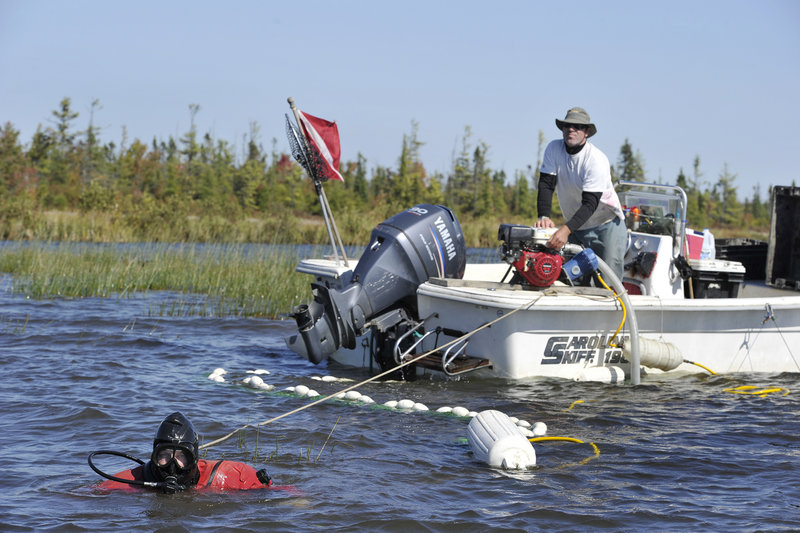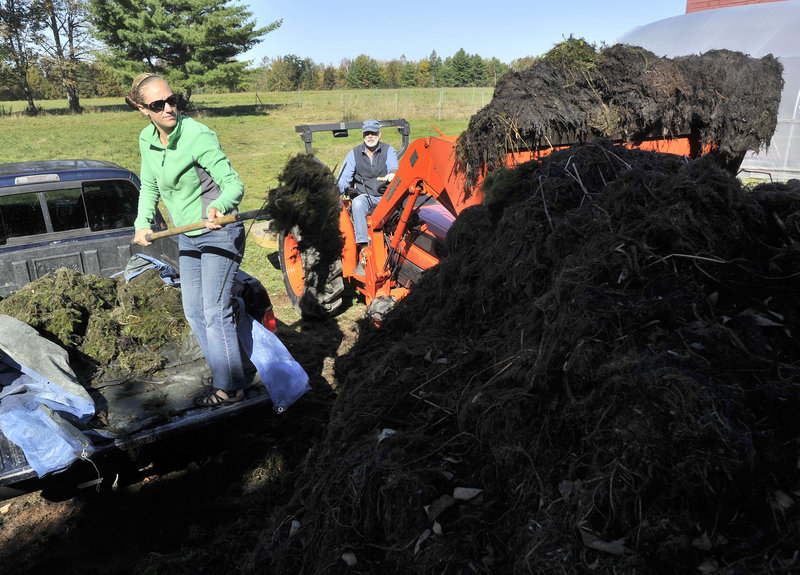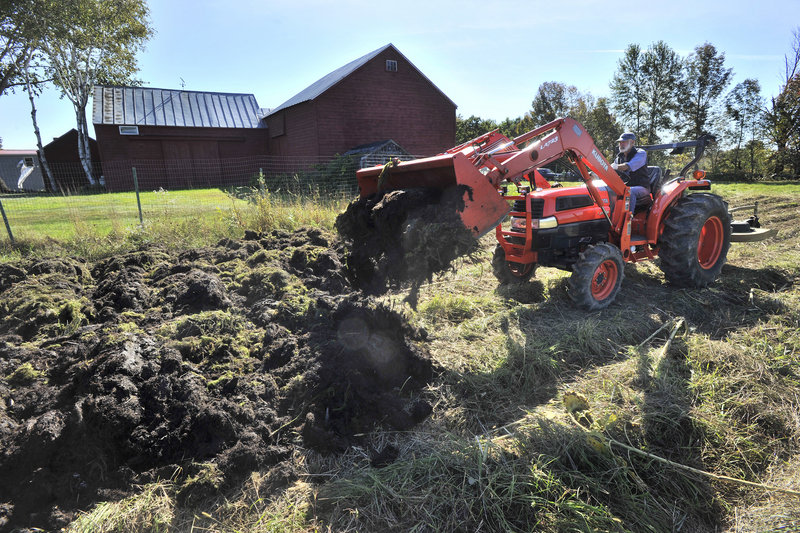BELGRADE – What do organic farming, scuba diving, sunflowers and 42,000 gallons of freshwater plants have in common? A sad story in the Belgrade region that locals are determined to turn into a recycling success story.
Since the effort began to remove variable-leaf milfoil from Great Pond and Great Meadow Stream in 2010, the Belgrade Regional Conservation Alliance has faced off with the invasive plant problem with gusto. And this summer it took the first step toward trying to eradicate the invasive plant while it turns mountains of milfoil into a composting science project.
“BRCA has taken out a large volume this year. This level of commitment and the time put into this plant from one body … It’s a very impressive project,” said John McPhedran, the invasive aquatic plant coordinator with the Department of Environmental Protection.
To date, there are 23 infested watersheds in Maine that are choked with invasive plants, according to the DEP. And, to be sure, many lakes associations are attacking the problem, and have been for years.
But the large-scale effort taken in the Belgrade region this summer may be unparalleled.
After pulling up 3,000 gallons of the plant in 2010, the Belgrade Regional Conservation Alliance this summer hauled more than 42,000 gallons out of Great Pond.
“We quickly realized we needed a “stop milfoil” campaign. So far we’ve raised $261,000 to try to stop the problem. And we’re trying to raise $500,000,” said Toni Pied, the alliance’s milfoil director.
The group that looks after the waters of the famous fishing region wasn’t going tot use volunteers and brochures only to try to educate and stop the spread. So it hired off-duty game wardens to do the boat checks to add weight to its message.
“That was very useful. Anyone who they got close to, they had a conversation with. They said people seemed receptive, and a lot didn’t know,” Pied said.
Then, the alliance hired a 10-year-old company that has specialized in a large-scale milfoil removal. New England Milfoil, started by urchin diver Cliff Cabral, has worked to clean some of the most infested lakes in New England. The divers on Cabral’s team went after the Great Pond infestation with the intent to wipe it out.
They were able to harvest 1,600 gallons a day. By Sept. 27, they had pulled for 60 days and harvested 42,000 gallons of milfoil from Great Pond.
“This is unique in that no project lets us go in and work at it. (BRCA) are determined,” Cabral said.
Most lakes associations hire the divers for a week a summer, hoping to beat milfoil back, he said. But the Belgrade alliance wants to believe it can be eradicated. So Cabral has gone to some patches of shallow water and pulled up the root four and five times.
“Maybe it won’t grow back there,” he said.
Meanwhile, at the Wall farm in Belgrade, a giant pile of milfoil gives off steam on a cool fall day as it’s hoisted by Alex Wall’s tractor and spread across a field where sunflowers grew.
This, too, is a unique effort in the Belgrade milfoil fight: turning something frightening into something useful. Composting milfoil is not new, but not widely done, McPhedran said.
It’s been done on Little Sebago and by the Lakes Environmental Association with a local nursery in Bridgton.
But the Belgrade alliance plans to figure out what crops its milfoil works best on — since it has so much of it.
“This should be good for composting. It has tons and tons of nitrogen in it. Or my nose told me it does,” Wall said.
As Kathi Wall drives her car out in the fields to check on her husband, she watches with excitement the first stage of their composting experiment. A retired nurse and former teacher, she hopes to try a milfoil mix with horse manure.
“We’ll have a control area. And we hope to do chemical testing on it. It could be the next seaweed,” she said.
But the reality is, nobody knows if the Belgrade effort will end in success as far as eradicating milfoil.
McPhedran said it’s difficult to achieve since variable-leaf milfoil’s seeds spread so easily.
There are nearly 50 water bodies in the 23 infested watersheds, and only once has a water body been taken off the list. Last year, Little Range Pond in Poland was removed from the state’s list.
“What they’ve shown this year is if you work really hard at it, they’ll knock this thing back dramatically. It will be very interesting to see what comes back next year,” McPhedran said of the Belgrade effort.
Staff Writer Deirdre Fleming can be contacted at 791-6452 or at:
dfleming@pressherald.com
Twitter: Flemingpph
Send questions/comments to the editors.






Success. Please wait for the page to reload. If the page does not reload within 5 seconds, please refresh the page.
Enter your email and password to access comments.
Hi, to comment on stories you must . This profile is in addition to your subscription and website login.
Already have a commenting profile? .
Invalid username/password.
Please check your email to confirm and complete your registration.
Only subscribers are eligible to post comments. Please subscribe or login first for digital access. Here’s why.
Use the form below to reset your password. When you've submitted your account email, we will send an email with a reset code.